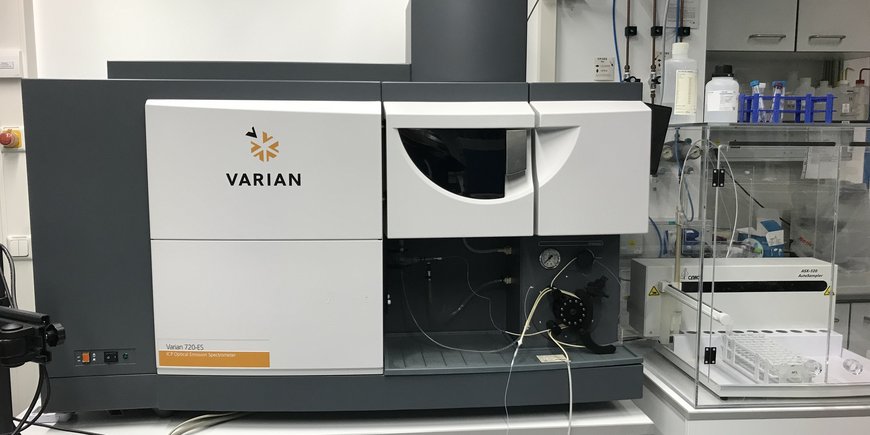The ICP-OES (Inductively Coupled Plasma Optical Emission Spectrometer) allows simultaneous detection and quantification of most elements in solutions at concentrations ranging from a few ng/g (ppb) to hundreds of µg/g (ppm). We analyse a wide selection of environmental samples for element concentrations, ranging from rock, soil, river water, seawater, and plant materials. We routinely analyse and quantify the following Elements: Li, Be, B, Na, Mg, Al, Si, P, S, K, Ca, Sc, Ti, Cr, Mn, Fe, Ni, Co, Cu, Zn, Ga, Ge, Rb, Sr, Ag, Cd, Ba, Pb, Bi.
The HELGES-laboratories are equipped with two types of optical spectrometers. The Varian 720-ES ICP-OES with an axial observation of the plasma offers high sensitivity and low detection limits, which is particularly suitable for low-concentration samples. The SpectroGreen ICP-OES has a radial plasma observation, which offers a high tolerance for samples with high salt loads and other complex matrices, thanks to the low matrix interferences.
Sample preparation
For most applications we use ICP-OES analyses on solutions, hence, solids must be dissolved prior to analyses. There are several methods of dissolution using different acids (nitric, hydrochloric, hydrofluoric acid) or alkali fusion (e.g., NaOH). The amount of sample needed depends on the element of interest and if it is a major (wt%) or minor (ppm) component of the sample. Typically, for rocks or plants (wood, leaves) 50 – 100 mg powdered sample is needed, for water samples (stream or ground water) about 1 – 10 ml is used, which is typically further diluted to a minimum of 2-5 ml for quantitative simultaneous determination of cations. ICP-OES is a relative measurement method and therefore the instrument requires calibration prior to each measurement. To obtain accurate results the calibration standards need to be prepared in a similar matrix than the samples to be analysed. Hence, a rough estimate of the sample composition is required, which might be obtained by a first screening analyses by ICP-OES or by other analytical methods.
A few requirements before samples can be measured by ICP-OES:
Complete dissolution is required. No particles must be present in solution. Natural water samples must be filtered using 0.2 µm or 0.45 µm pore size filters.
Samples are typically prepared in <2% HNO3 (<0.5 mol/l, suprapure grade), but other acid matrices (e.g. HCl) or acid concentration can be used, if required. Samples must be diluted to fall within the calibrated working range of the ICP-OES. Different dilution factor might be necessary for one sample, depending on the concentration of each element of interest in the sample.
Preferably no HF acid should be introduced into the machine because the ICP-OES sample introduction system contains glass parts. If HF is used in the dissolution procedure, it must be evaporated or neutralised (<0.001M HF in the analyte solutions). If HF-bearing solutions are unavoidable a PFA sample introduction system must be used. Available sample introduction systems are Cyclon-type glass spray chamber, Scott-type PFA spray chamber and a desolvator (APEX-Q and APEX-HF) equipped with glass or PFA nebulisers.
The capabilities of qualitative and quantitative detection varies strongly between different elements, and some elements cannot be analysed using ICP-OES. Levels of detection vary for each cation, ranging from 0.001 to 0.1 µg/ml.


![[Translate to English:] Spectro](/fileadmin/_processed_/5/5/csm_I-08_SPECTRO_ICP-OES3_761e7d92c6.jpeg)
![[Translate to English:] Plasma](/fileadmin/_processed_/5/e/csm_I-08_SPECTRO_ICP-OES2_25cbc87faa.jpeg)
![[Translate to English:] Plasma](/fileadmin/_processed_/8/1/csm_I-08_SPECTRO_Plasma_82ed7cd788.jpeg)


